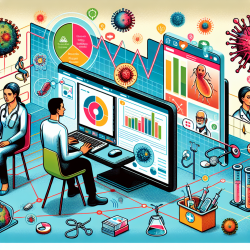Introduction
In the realm of clinical trials, patient recruitment and retention pose significant challenges, affecting 90% of trials directly. The costs have quadrupled over the last two decades, while the approval rate for new drugs has halved. Addressing these challenges requires innovative approaches to patient monitoring and retention. Enter ClinicalGAN, a groundbreaking generative AI framework that creates patient digital twins to enhance patient monitoring and retention.
What is ClinicalGAN?
ClinicalGAN is a generative architecture that simulates patient journeys by creating digital twins, providing a comprehensive view of potential patient trajectories. It leverages patient meta-data for personalized generation, predicts dynamic termination, and incorporates multi-variate time-series training. Validated on Alzheimer’s clinical trial datasets, ClinicalGAN outperforms existing methods by 3-4 times across generation quality metrics and significantly improves drop-off prediction accuracy.
How ClinicalGAN Transforms Patient Monitoring
- Personalized Patient Generation: ClinicalGAN uses patient meta-data to generate personalized patient journeys, allowing for tailored monitoring and interventions.
- Dynamic Termination Prediction: By predicting patient drop-offs dynamically, ClinicalGAN enables proactive interventions to improve retention.
- Enhanced Multi-variate Analysis: The framework models complex relationships among various test measures, capturing the dependencies and interactions crucial for accurate monitoring.
ClinicalGAN vs. Traditional Methods
Traditional methods in clinical trials often rely on deterministic frameworks, which fail to capture the stochastic nature of patient journeys. ClinicalGAN, however, embraces this variability, offering a more accurate and comprehensive understanding of patient behavior. Its generative approach allows for the simulation of multiple possible trajectories, providing insights that deterministic methods cannot.
Empirical Validation
ClinicalGAN has been empirically validated on Alzheimer’s clinical trial datasets, demonstrating superior performance in generation quality and predictive accuracy. It outperforms state-of-the-art approaches in generating realistic patient data and predicting patient drop-offs, making it a valuable tool for improving clinical trial outcomes.
Implications for Practitioners
For practitioners in speech-language pathology and related fields, ClinicalGAN offers a data-driven approach to patient monitoring. By implementing ClinicalGAN, practitioners can enhance their understanding of patient trajectories, leading to more effective interventions and improved outcomes. The framework’s ability to simulate patient journeys provides a powerful tool for anticipating challenges and optimizing patient care strategies.
Conclusion
ClinicalGAN represents a significant advancement in the field of patient monitoring and retention in clinical trials. Its ability to generate realistic patient digital twins and predict patient drop-offs with high accuracy makes it an invaluable tool for practitioners seeking to improve clinical trial outcomes. By embracing generative AI, practitioners can unlock new possibilities for patient care and clinical research.
To read the original research paper, please follow this link: ClinicalGAN: powering patient monitoring in clinical trials with patient digital twins.










